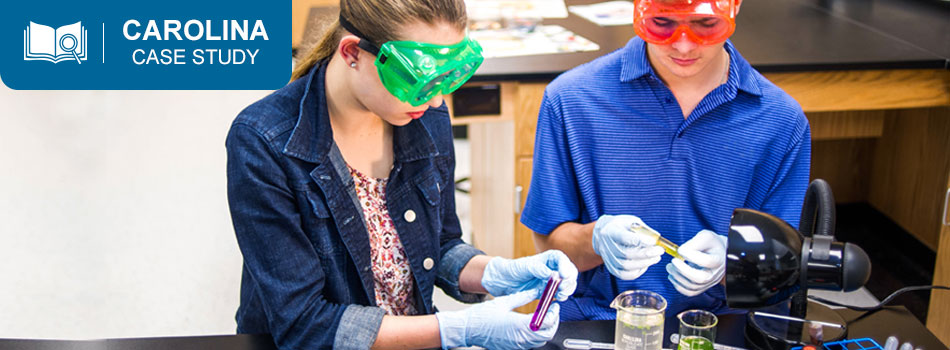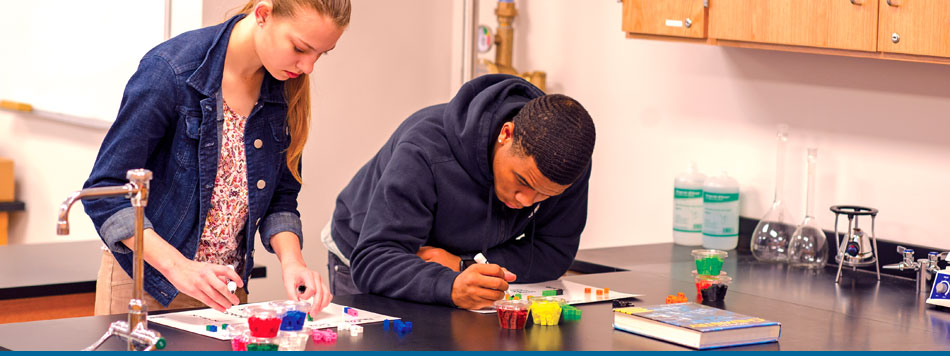My Cart
Your Shopping Cart is currently empty. Use Quick Order or Search to quickly add items to your order!

FAST FACTS
Ginger Demers,
Rio Hondo Prep School,
Arcadia, CA
Mary Buchanan,
Sir Francis Drake High School,
Larkspur, CA
Richard Smith,
Buena High School,
Ventura, CA
Spark student interest in labs, build their 3-dimensional learning skills as outlined in the Next Generation Science Standards* (NGSS), and make it easy for teachers to integrate 3-dimensional instruction into their classes.
Use Carolina Kits 3D™ labs that use phenomena to support NGSS and 3-dimensional instruction.
Students get excited about the real-life focus of the Carolina Kits 3D™ labs, which helps build their 3-dimensional learning skills; teachers benefit by being able to integrate 3-dimensional instruction into their classes.
Science teachers are turning to investigative labs with object-driven phenomena to gain student interest and understanding.
Ask any science teacher about the keys to a successful lab experiment, and “getting students interested” is at the top of their list. Without student engagement, the lab becomes just another assignment to complete and then leave behind. But when students get excited about a lab, they carry what they learn with them for a lifetime. You probably have a few persistent memories of an early school lesson that really grabbed your interest, and it still comes to life in your mind many years later. That is the power of using real-life phenomena in lab investigations.
"Integrating 3-dimensional learning into labs" is another top priority for teachers, as an increasing number of schools are adopting the NGSS, or phenomena-based science standards. When students develop an intuitive habit of using all three dimensions of learning, it provides them with a skillset they can use in all areas of life.
So, what can be done to increase the odds of students embracing their lab studies, and how can this be done within a three-dimensional learning environment? At Carolina, we continuously seek input from teachers on what is working well for them and what they need to meet these goals. We recently asked several middle and high school teachers for feedback on how the Carolina Kits 3D™ labs help them do just that.
"The Carolina Kits 3D™ labs enable my students to understand and be able to explain the characteristics of ionic and covalent bonds before they ever hear it in lecture."
—Ginger Demers, Science Department Chair, Rio Hondo Prep School, Arcadia, CA
Ginger Demers uses Carolina Kits 3D™ labs in her middle and high school science classes at Rio Hondo Preparatory School in Arcadia, California. Demers appreciates how the Carolina Kits 3D™ Chemical Bonding Kit cleverly uses the Mars Rover explorations as a backdrop for the lab. "Most students are fascinated by the Mars exploration," she explains, "and even more so when we talk about how the types of molecules found on Mars can be used to evaluate the potential for living things to exist there."
Demers describes how student learning is improved when students are more engaged in the lab. After completing the chemical bonding lab, "even my lower level students can tell you that the Mars Rover is searching for life because the signs of life are organic molecules covalently bonded. They can go over the three tests they did and explain how they can tell the difference between covalent and ionic compounds. This is so much better than memorizing a list of properties!"
Demers also uses the Carolina Kits 3D™ Molecular Structure Kit. After learning about different plastic polymers, students divide into teams and compete to design the best plastic for a particular use, such as a clear storage bag or a super-bouncy ball. "The students really enjoy the design challenge and competing with other teams makes it even more fun for them!" says Demers. "Student engagement is much improved with the 3D kits."
Chemistry students at Sir Francis Drake High School in Larkspur, California, are also embracing the Carolina Kits 3D™ labs. Their teacher, Mary Buchanan, explains that her students "really, really like the molecular structure lab with its hands-on work and design challenge." Buchanan also considers the design challenge to be a helpful way for teachers new to the NGSS to learn how to incorporate modeling and design into their labs.
Richard Smith uses the Carolina Kits 3D™ Chemical Bonding Kit in his chemistry classes at Buena High School in Ventura, California. His students really enjoy the hands-on work of the lab (especially burning things!), which helps to keep them engaged. He is also impressed with how "the good organization of the kits makes it easy for students to dig right into the labs and avoid being frustrated and losing interest." As a result, Smith finds he is able to enjoy observing his students conduct their experiments, which in turn encourages him to include more labs in his classes.
All three of these teachers noted the exceptional organization of the kits and the easy-to-follow instructions for conducting each lab. These details make the experiments very approachable for students and easy for teachers to implement and use the kits.
"The students really enjoy the design challenge and competing with other teams makes it even more fun for them!"
—Ginger Demers, Science Department Chair, Rio Hondo Prep School, Arcadia, CA

In keeping with the phenomenon-based approach of three-dimensional learning, the Carolina Kits 3D™ labs begin with a real-world event or situation—known as the "anchor phenomena"— that students can observe and consider. This is the focus of the lab to help students integrate the three dimensions of learning and gain a deeper understanding of the phenomenon.
Teachers find the phenomenon-based approach an effective way to gain and expand student interest. The molecular structure kit, for example, uses an introductory video to introduce students to the variety of plastic types used in different products. Buchanan says some of the products are everyday realities for students, while other uses of plastics are "real eye openers for them." She describes how this introduction to diversity of plastic polymers "really expands the students’ realization of how many products contain plastic and how their physical and chemical properties reflect their intended use."
Students in Demers’ classes are also intrigued by their phenomenon-based experiments. In the chemical bonding lab, her students first consider how the substances discovered on Mars are evaluated for their physical characteristics, including the types of chemical bonds they contain. The students then conduct hands-on tests of several known substances to learn the observable characteristics of different chemical bonds.
The ultimate goal of phenomenon-based learning is for students to learn to make sense of the event or situation and be able to extrapolate their findings to similar phenomena. The chemical bonding lab encourages this by asking students to identify an unknown substance’s bond type by applying what they previously learned about the bonds of known substances. The molecular structure lab does so by asking students to design their own specific-use plastic using the knowledge gained from their earlier study of the characteristics of different plastic polymers.
These multi-step, multi-day labs lead students from phenomenon introduction and consideration, through experimentation, and finally to application to unknowns or a design challenge. As Demers confirms, "this approach really improves student learning." She explains that the lab’s "cookie recipe" approach to the basic chemistry of the polymer lesson is then reinforced when students apply that learning to the polymer design competition. "Students have no problem picking out on a multiple-choice test that polymers are covalently bonded and that they are repeating patterns of the same molecule which lead to the properties they discovered in lab."
Carolina is committed to helping students and teachers succeed in the many different ways such success is measured. The Carolina Kits 3D™ labs use real-life phenomena to capture students’ attention and strengthen their three-dimensional learning skills. The comprehensive and user-friendly kits help teachers easily integrate 3-dimensional learning into their classes so both students and teachers can enjoy the labs.
Learn more about the science-educator developed and reviewed teacher’s manuals, student guides, pre-prepped lab materials, engaging activities, and digital lab resources that make up Carolina Kits 3D™ labs at www.carolina.com/3D.
*Next Generation Science Standards® is a registered trademark of Achieve. Neither Achieve nor the lead states and partners that developed the Next Generation Science Standards were involved in the production of, and do not endorse, these products.